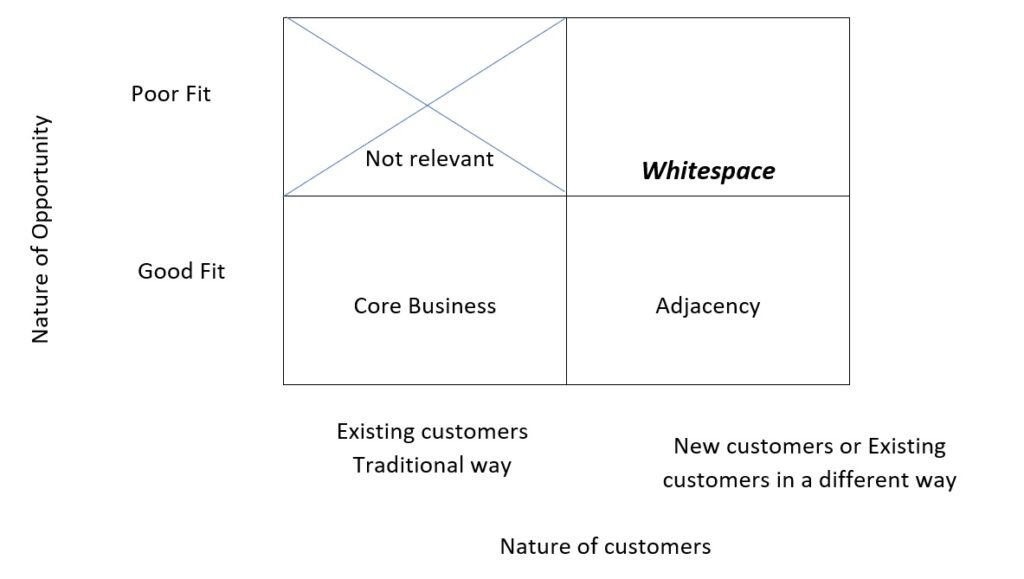What is a growth strategy in business?

What is a growth strategy in Business? Business model innovation for growth
What is a Growth Strategy in Business? – A plan and operating model enabling the business to grow by differentiating from the competition. It leverages the core competencies and gains significant advantages over the competition, resulting in a dominant share in the market with higher profit margins! Many business model innovations help to create breakthrough business results. We will see one of the business model innovations in this blog.
Business growth strategy – A need to continuously evolve!
Many companies wish to grow but often find themselves in a war with the competition and often leading to the following challenges.
- Price war leading to lower profit margin
- Positioning the USP of the company strongly
- Unable to expand business
- Retaining the key resources
Hence, Companies are in need to continuously keep evolving their strategies to beat the competition and grow. Some of the key considerations that help to overcome the above challenges are
- How to use my existing core competencies/resources and create new business opportunities for growth?
- What products/services will yield higher profit and what are the ways to achieve higher profit?
- Getting ahead of the competition to gain market share!
Business models & innovations in business models uncover/discover the potential within the organization and grow the business.
Business Model Innovation – “Seizing the white space”
The health insurance company example explains this model.
-
Core Business:
- This is the existing business with the core competencies and delivering business in an existing way < Example: A Health Insurance company selling insurance to a retail segment of customers >. The core competency is the ability of the organization to sell health insurance to retail customers and knowledge about health insurance products.
- Adjacency : This is the adjacent segment < Example: The same insurance company getting into a commercial segment of selling insurance to corporate employees >. Selling to corporate employees through companies is a different segment. When selling to companies, the company gains access to sell to many people through a single corporate channel. The corporates might need different terms and conditions compared to selling to a single retailer. The competencies, process, terms, and conditions differ from selling to the retail segment.
- Not relevant : The same insurance company trying to venture into selling financial products such as mutual funds for retail and corporate segments. Even though the company might have a strong capability in selling some products, from the insurance company’s perspective, the market, the market size, and the needs of people purchasing the product are completely different.
- White Space – This is a space of innovation. Conventionally the health insurance amount Is based on the fixed premium. Based on the premium the coverage scope of coverage varies. The scope might vary depending on the number and type of diseases, or a cap on the amount for which the claim can be made. For example, some insurance might consider diabetes under their coverage and some might not. In the same way, the amount that can be claimed might also vary.
The key point in the conventional model is that payment to hospitals depends on the service the patients received and according to the insurance taken. In general, insurance payments to hospitals or health, providers do not depend upon the quality of treatments given to the patients.
- The insurance company found a white space – Pay the insurance and expenses – for the quality of the health services received! This is completely a different way of offering the services when other insurance companies are not offering these kinds of services depending on the quality of the treatments received. This is a business model innovation. The existing way of delivering is completely changed. This is a pain point for patients for whom quality services are not delivered.
Components of the Model:
- This model addresses 3 components:
- (a) A new customer value proposition (pay for the quality), – The customers paying a fixed amount for the insurance is changed to pay for the quality of the service provided. This also pushes the boundaries of the service providers to provide quality service.
- (b) Utilizing existing Key resources & processes (core competencies) – Here the company is trying to leverage the existing resources and processes with required changes. The core services of offering health insurance to the people by leveraging the resources and processes remain the same.
- (c) New profit formula (unpredictable income and profit) – The company is moving from a predicted revenue system to a riskier system of variable/output-based revenue system. Depending upon the quality of the service providers, the premium paid by the customers will also increase or decrease. However, the insurance company cannot directly control the health service providers to deliver quality.
- The Insurance company realized that a new ecosystem has to be developed. This requires a network of hospitals, hospital staff, device manufacturers, etc. to deliver greater value to the people, with a differentiated pricing model.
- In the new ecosystem, all the stakeholders are connected in a single platform so that the quality of the services can be tracked from the customer onboarding (patient registration) till customer service is completed (patient treatment completed).
- The new ecosystem is complex and difficult to replicate. This is also a defensive mechanism for the company from the competition to imitate.

-
Key characteristics of the model
- Leverage the core competencies
- Differentiate themselves by new profit formula
- Creating new business segments.
- Address 3 components – Customer value proposition, Core competencies (Key resources and Key Processes) & Profit formula.
What is a growth strategy in business – A case study of Software service company: Applying the business model innovation “Seizing the white space model “.
Company’s overview/ Core Business: This is a small company delivering aftermarket software solutions to Automotive component manufacturing companies. The company has gained significant domain knowledge about its customer base. So far, the company was developing bespoke software applications, mostly at a fixed price model. The company faces severe margin pressures in winning the deals. The company plans to expand the business and at the same time migrate to value-based offerings to gain higher profits and also beat the competition.
- Adjacency: The company started developing ERP applications for the Sales function and expanded the business.
-
White Space:
- One of the key challenges their customers are facing is to bring in efficiency and improve quality at the factory shop floor assembling units.
- This small company found that this business area is not being addressed by large players, as the customers are cost-sensitive and not willing to take risks by investment. In addition to that, the systems on the shop floor are legacy systems.
- The company identified, Digitalization of the shop floor assembly unit as the white space. By leveraging its relationship with the customers got insights into the operations. With the new insights, the company is poised to offer AI platform-based solutions to automate shop floor operations. This business model innovation is a win-win for the customers and the company.
- A differentiated pricing model is being planned as the company is planning to roll across different customers and to multiple units for the same customer.
Growth Business Strategy – Opportunities:
- The adoption of digital transformation has increased rapidly post-pandemic. In a way, the digital transformation led to offering differentiated offerings at scale, with new user experiences.
- Companies like ANT, Intuit, Tencent, BYJU’s, etc., are using the cloud, and AI technologies to give more personalized experiences. This differentiates from the conventional players not only in the service and also by using differentiated pricing models.
What next?
- Companies need to look at these kinds of models to explore how they can replicate some of the success of these kinds of models.
- Create a long-term plan to incorporate these technologies and business model
- Work closely with the customer and create long-term partnerships.
- Execution – the key element of success.
- Make the necessary investment!
Key references
- If you would like to know more about “growth business strategy”, “business innovation model” and more importantly “Seizing the white space” – you can search for Seizing the white space by Mark W Johnson.
Related Articles
Also Check Hyper-Personalization – The New Possibilities In The Digital Era!




Sivaram Dhara
October 17, 2022Information and thought provoking article. Concept of growth strategy is clearly explained.